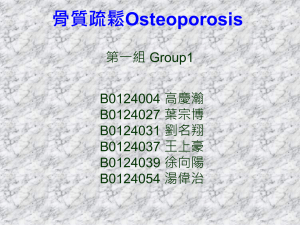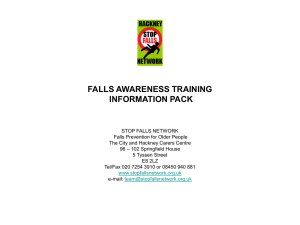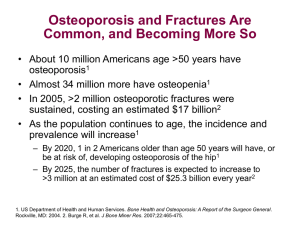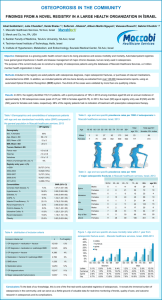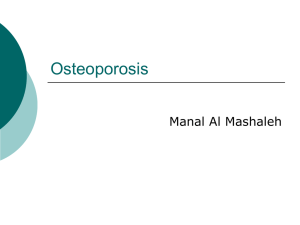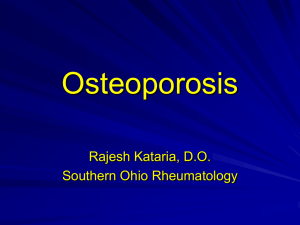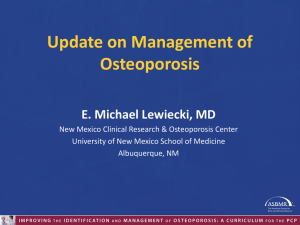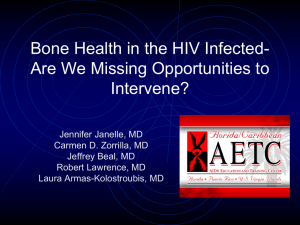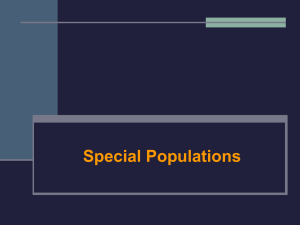Gait, Balance and Osteoporosis Treatment in Seniors
advertisement
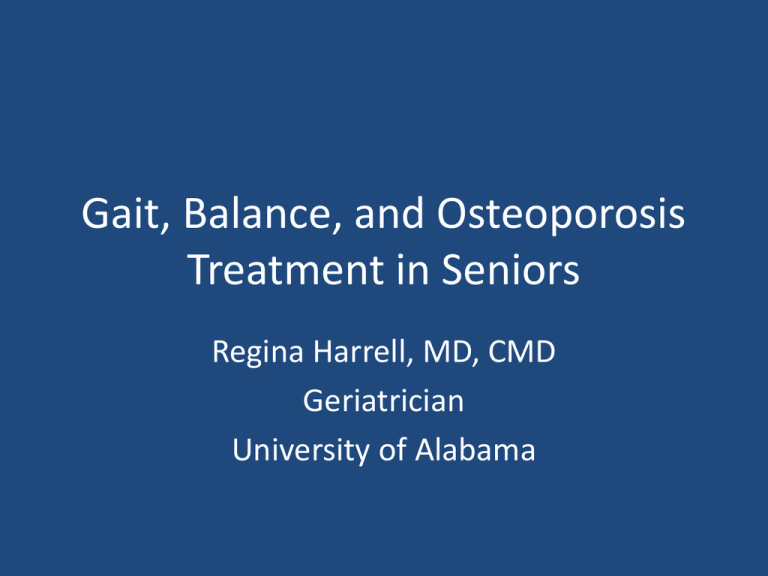
Gait, Balance, and Osteoporosis Treatment in Seniors Regina Harrell, MD, CMD Geriatrician University of Alabama “You can tell a man’s health by what he takes two at a time: pills or stairs.” Objectives • Know how to assess gait and balance in an older population. • Learn interventions to minimize fall risks. • Know the differences between gait assistance devices. • Know the risk factors and how to reduce them for osteoporosis. • Learn health benefits of exercise in addition to osteoporosis risk reduction. • Learn the basics of osteoporosis treatment. • Learn how the treatment of osteoporosis changes with age and comorbidity. Normal Gait • Get Up and Go Test – Start sitting in a chair. – Stand without using hands to push upwards. – Walk 10 feet. – Turn around and walk back to chair. – Sit down. • Normal <10 seconds. • Abnormal > 20 seconds. • Simple, sensitive screen for ALs. Tinetti Gait and Balance Test • 10-15 minutes to complete • Most often done by a therapist. • Scoring is done on a three point scale with a range of 0 to 2. 0 represents the most impairment, while a 2 represents independence of the patient. • Gait and balance are assessed separately and the scores are then totalled. Tinetti Gait and Balance Test • • • • The maximum score for gait is 12. The maximum score for balance is 16. The maximum total score is 28 points. In general, a score below 19 is a high risk for falls. • Too sensitive, not specific enough for ALs. • http://www.sgim.org/workshop01/pdf/hando ut16TinettiAssessmentTool1.pdf There is more to walking than walking. • Medications • Vision – “I leave my glasses next to my bed.” – Cataracts, macular degeneration • Postural blood pressure – 20mmHg drop in systolic pressure – 10mmHg drop in diastolic pressure • Neurological diseases • Cardiovascular diseases • Musculoskeletal problems Medications • • • • • • • Benzodiazepines Sedative/hypnotics Antihypertensives Antidepressants Neuroleptics Alcohol Illegal drugs Comorbid diseases • • • • • • • • Increase risk of injury from fall as well Osteoporosis Steroid-thinned skin Anticoagulants Arthritis Dementia Pain Acute infection Interventions to Decrease Risk • • • • Not all falls are preventable. If a risk is fixable, fix it. If a risk is not fixable, minimize it. Plan of care documentation Interventions to Decrease Risk • • • • • • • Gait training Tai Chi Dancing Exercise Footwear Restraints Hip protectors Hip Protectors • Decrease risk of fall injury • Do not decrease risk of fall • Very effective, difficult to consistently use Gait Assistance Devices--Cane • Widens base of support • Single-tip cane – Offset – Crook-neck Gait Assistance Devices--Walkers • • • • 5-inch wheels for ease of movement 15-30 degree elbow bend Handles at greater trochanters 4-wheel walker – Light support • No-wheel walker – Large amount of weight-bearing support – Extreme fear of falling – Too heavy for severe CHF, deconditioning, osteoporosis Gait Assistance Devices--Walkers • 3-wheel walker – Not for weight-bearing – Pretty colors – Keeps up with the Joneses – Convenient for groceries Gait Assistance Devices--Walkers • Merry Walker – Patients with dementia – Can’t remember they are unsteady – Generally for facility use Osteoporosis: Definition • Not enough bone in your bones • DEXA bone mineral density scan – Osteopenia= thin bones, some risk – Osteoporosis= thinner bones, higher risk • T-score -2.5 or less Why is osteoporosis bad? • Half of women over 50 will have an osteoporosis-related fracture • Hip fracture after one year – 1/3 recover completely – 1/3 cannot walk independently – 1/3 die • Broken bones hurt – Spine fractures notorious for pain problems • Independence Osteoporosis: Demographics • Affects 10 million Americans • 34 million Americans have low bone density and are at risk • 80% women • Causes 1.5 million fractures a year at a cost of $18 billion a year Osteoporosis: Risk factors • • • • • • • White or Asian race Smoking, alcohol Petite size Family history Estrogen, testosterone Some medications Diet Osteoporosis: Risk reduction • • • • • • • Stop smoking Avoid excessive alcohol Adequate calcium and vitamin D Pick good parents Exercise Exercise Exercise Exercise • • • • • • Reduces fall risk Increases bone density Improves joint mobility Improves heart and circulatory function Increases independence Improves balance Exercise • • • • • • Boring Causes pain Inconvenient Requires special clothing and equipment Expensive Takes too much time Boring • • • • Get a partner (misery loves company) Vary exercise type Vary exercise location For stationary exercises, talk on the phone, read a book, watch television, listen to music Inconvenient Cost • Wear clothes that are comfortable and easy to move in • Use bags of rice or cans of soup as one pound hand weights • Put food cans inside an old purse to put around ankles for weights • Walk in the mall, a large store, or church gym instead of a treadmill Pain • No pain, no gain • Not true Exercise: Where to start? • Start where you are comfortable • 3 goals: – Range of motion – Aerobic training – Strength • Work with a doctor, therapist, or personal trainer if you have serious health problems. Range of Motion: Where to start? Move your joints in all the directions they are supposed to move, gently and slowly. Increase time spent moving joints and the total angle moved. Depending on underlying disease, major improvements may take a month or more. Aerobic Training: Where to start? • Walk one minute a day. • Increase by one minute a day each week. • Goal is 25 minutes at least 4 times a week. Strength: Where to start? • Once range of motion is comfortable, add a small weight in each hand and around each ankle for range of motion movements. • Increase the number of repetitions weekly. • Once 2 sets of 10 repetitions can be done, increase weight again. • Goal is 25 minutes of strength training at least 3 times a week. Exercise as an Activity • • • • • • Create competitions Pedometers Add music Let residents make suggestions Certificates, flowers, massage rewards No candy bars as rewards Back to Osteoporosis • • • • • You are exercising You get enough calcium and vitamin D You quit your bad habits Your bones are still thin What next? Osteoporosis Medications • Calcium 1200 mg per day • Vitamin D 400 IU per day • All other medicines require adequate calcium (building blocks) to be effective Bisphosphonates • Increase bone density by slowing down the cells that break down bone • Pills: Alendronate (Fosamax), ibandronate (Boniva), risedronate (Actonel) • IV: pamidronate (Aredia), zoledronic acid (Zometa or Reclast) • Decrease fracture risk • Increase bone density Bisphosphonates • FLEX trial showed some women can stop treatment after 5 years – Improved bone density while on treatment – No fractures – T score > -3.5 • Stomach side effects • Weight bearing exercise required Selective Estrogen Receptor Modulator • Raloxifene (Evista) daily pill • Also reduces breast cancer risk • Increases venous thrombosis blood clot risk Parathyroid Hormone • Teriparatide (Forteo) • Daily injection for up to 2 years • For severe osteoporosis only Other Osteoporosis Medicines • Calcitonin (Miacalcin) daily nose spray – Mostly used for pain related to vertebral fractures • Estrogen – Side effects controversial Osteoporosis Treatment Considerations • • • • • • Other concurrent illnesses Life expectancy Ability to swallow pills Side effects Cost Ability to exercise References • Tinetti, Mary. Preventing Falls in Elderly Persons. NEJM 2003;348(1): 42-49. • Vu MQ, Weintraub N, Rubenstein LZ. Falls in the Nursing Home: Are They Preventable? J Am Med Dir Assoc 2004; 5:401-406. • Nied RJ, Franklin B. Promoting and prescribing exercise in the elderly. Am Fam Physician 2002;65(3):419-26,427-8. • www.nof.org National Osteoporosis Foundation • Fracture Intervention Trial Long-Term Extension, JAMA, December 2006

